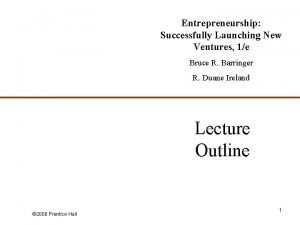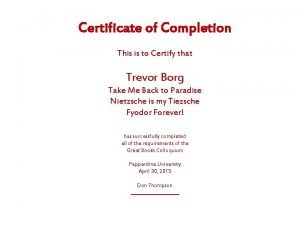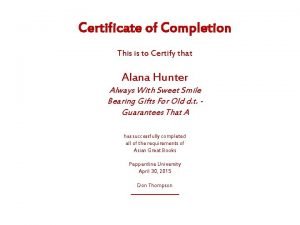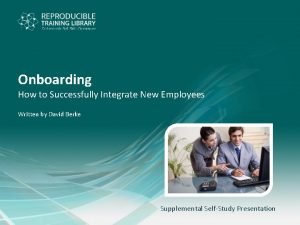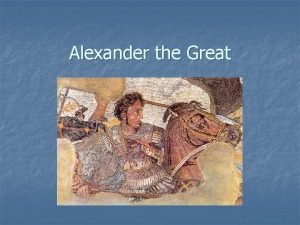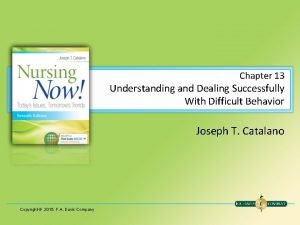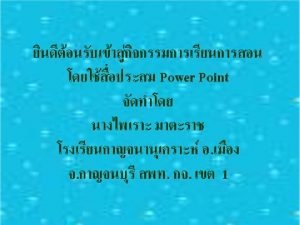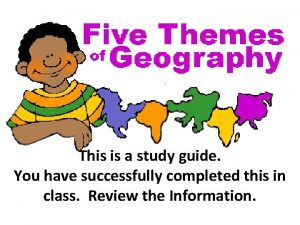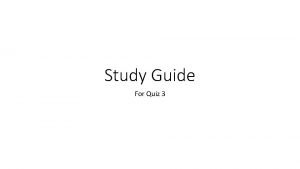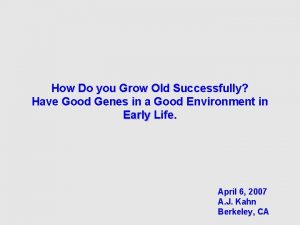This is a study guide You have successfully












- Slides: 12

This is a study guide. You have successfully completed this in class. Review the Information.

Plant and animal life varies on our earth. This means that there is great diversity on our earth! Questions We can see that just by looking out the window. physical We know that the science describing how things Geography diversity vary from place to place is the science of choose Geographer geography. This is a simple description of Varies geography but we know that a geographer is always examining these places, seeing how they are alike and different, and how the differences in those places with their natural features can affect how and where people choose to live. Geographers always ask questions like “where do you live? ” and “why do you live there? ”

We have already learned that people need a way to describe where things and people are. This is what we call location. Maps have resulted from needed a way to locate places and things. One of the most important parts of a map is the grid, where the lines intersect. Remote Grid Location popular Maps Global address Once grids were established, map making became more and more popular. Using a grid gives each spot its own global address, or spot in our world, so to speak. With our technology today, we can find directions in very remote areas, or areas that are far away from civilization.


Around the world, PLACES are very different. This is one of the five major themes of geography. Places differ in their physical features, the types of people, the language that people use to communicate with each other, the kind of architecture or building, and also in the kinds of attitudes, (opinions and perspectives) that people display. All of these factors make a place very unique and able to stand out from other places. Place often refers to the many physical characteristics of a certain area. Place differs from location – where location specifies an exact spot, place will give us much more information. Place also includes natural and man-made landmarks along with the climate of the area. The physical characteristics of a place help to determine where people live and do their business. Certain buildings will also help to define a place. Unique Architecture Themes Attitudes Exact Features define Language Information Natural


Farm Build Natural Relationships systems Changes Interacting develop bridges Humans must work with natural features around them. By working with these natural features, changes might be made. Humans can actually create the place where they live by interacting with these features. This is referred to as relationships within a place or the human-environmental interaction. People build roads for transportation. They build rivers to cross over bodies of water. They create systems in different areas – like a sewage system in a city or an irrigation system on a farm. People must constantly problem solve to work in unison with their surroundings. People who create systems in communities are called city planners. These people help to develop the relationship with a place.


Movement in another major theme of geography. However, this isn’t just going from place to place. Movement involves the movement of people themselves as well as their goods (the things they produce and manufacture). Also involved in movement is the movement of people’s ideas and ways of doing things. How can an idea move? Well, one person takes their ideas to another place and starts a business or teaches other people. Geographers are very interested in what happens when people move around. Populations, or large groups of people, throughout history, have shifted from one place to another. When people move from place to place they take their customs, ideas, language and other unique ways of doing things with them. Together, all of these customs, ideas and ways of doing things form a CULTURE. Business Theme language Goods Ideas Populations culture geographers


Geographers are constantly asking questions about where things came from. They are very curious but at the same time this is very scientific. The place where NEW ideas, customs and objects first appear is called the HEARTH. When cultures are spread from one place to another, it is called “Cultural Diffusion”. This spread of cultures happens by people teaching other people. Today, with our advances in technology, cultures can be spread easily and efficiently. Culture is spread through media – magazines, newspapers, radio, internet sites, google applications and more! People that share the SAME culture often live close to each other. REGIONS are defined by the sharing of culture – this could be a cultural region. But regions are also defined by the physical factors like climate and landforms. Climate is different than the weather. Climate is defined as the weather conditions in a certain area over a long period of time. If you lived close to the equator, you would live in a tropical climate. One example of region is the Southwestern United States. Here you will see Spanish ethnicity, catholic religion, a lot of Spanish language and a lot of desert. Period Technology Religion Close Regions weather Cultural diffusion tropical Hearth media

Overview Flowchart With examples
 It is not you they are rejecting but me
It is not you they are rejecting but me A cube has 6 faces 12 edges and 8 vertices
A cube has 6 faces 12 edges and 8 vertices Grant application successfully submitted
Grant application successfully submitted Successfully launching new ventures
Successfully launching new ventures Kali jelen
Kali jelen Arianne grimaldi
Arianne grimaldi How to successfully integrate new employees
How to successfully integrate new employees Your holding created successfully
Your holding created successfully Dealing successfully with difficult changes in your life
Dealing successfully with difficult changes in your life In 331 bce, alexander the great successfully invaded egypt.
In 331 bce, alexander the great successfully invaded egypt. Dealing successfully with difficult changes
Dealing successfully with difficult changes The more you study the more you learn
The more you study the more you learn If you had studied hard you would have succeeded
If you had studied hard you would have succeeded



